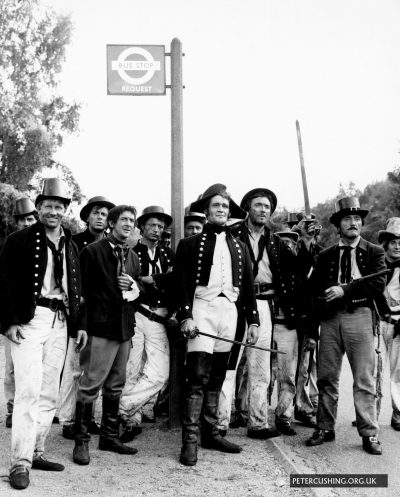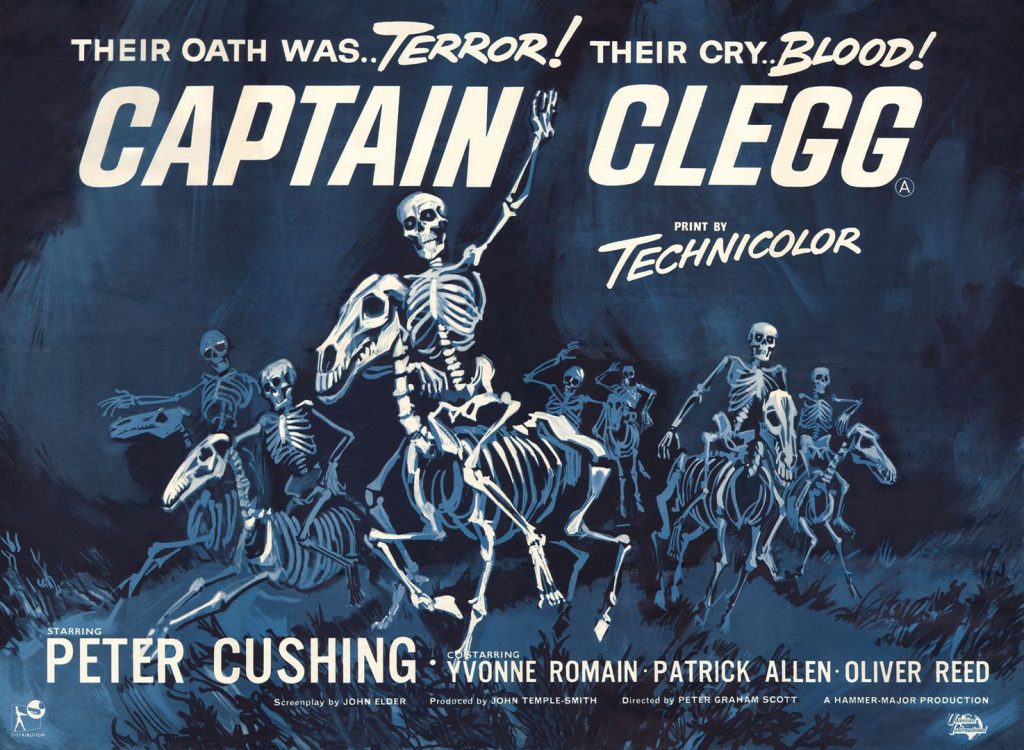
Rating: B-
Dir: Peter Graham Scott
Star: Peter Cushing, Patrick Allen, Oliver Reed, Yvonne Romain
a.k.a. Night Creatures
This is one which I had previously reviewed, so let’s start with what I thought about the film a decade ago.
In 1776, notorious smuggler Captain Clegg is eluding the British Navy. After one of the crew attacks his wife, the mulatto perpetrator has his tongue cut out and is dumped on a deserted island to die. However, the Navy, under Captain Collier (Allen), rescue him and he joins them. 16 years later, Collier is investigating smugglers based in the coastal village of Dymchurch, where Clegg’s grave lies. The mulatto leaps at Dr. Blyss (Cushing), the local parson, apparently enraged – but the illiterate mute is unable to explain his actions to Collier. It hardly counts as a spoiler to reveal that Blyss is actually Clegg, who faked his death at the hangman’s hands, to start a new life doing good [Well, if you discount his position as the head of the local smugglers, I suppose]. To add spice, the local squire’s son, Harry (Reed), has set his cap at Imogene (Romain), Clegg’s “orphan” daughter. That is not to the tastes of her guardian, who is also at odds with Blyss over the running of the gang.
Though Hammer were best known for their Dracula and Frankenstein horror movies, this is a lesser-known item in their collection, Cushing and Allen giving first-class performances as the adversaries. Blyss/Clegg is an ambiguous character, somewhat like Cushing’s Baron Frankenstein. We also enjoyed the luminescent skeletal costumes worn by the smugglers, even if this felt like something from Scooby-Doo. [Did they really have glow-in-the-dark paint in 1792? I doubt it.] Director Scott wasn’t a Hammer regular, but then, this is more of a swashbuckler than their usual fare, and he acquits himself well enough. While I can’t say the romance between Harry and Imogene sets the screen on fire, it’s there mostly to show Clegg’s humanity as the film heads towards its climax. The moral ambiguity here is quite startling given its time, and the production values are good enough to pull off the period atmosphere. If slightly out of the norm for the studio, it’s a solid piece of action-drama.
[Also starring: Allen also did the voice-over work for the UK government’s Protect and Survive films, which brought him fresh renown in the 1980’s as the voice-over on Frankie Goes To Hollywood’s Two Tribes: “Mine is the last voice you will ever hear…”]
July 2010
 Technically, this is a remake of the 1937 film Doctor Syn, though no such character exists by that name here. This is because its predecessor was adapted from the series of books by Russell Thorndike, the first of which, Doctor Syn: A Tale of the Romney Marsh, was published in 1915. At about the same time Hammer bought the rights to remake the movie, a rather larger studio bought the film rights to the books. As they say, you don’t fuck with the mouse, and after “discussions”, it was Disney who got to proceed with the character. The Scarecrow of Romney Marsh, starring Patrick McGoohan, became part of their Walt Disney’s Wonderful World of Color TV series, and was released theatrically in Britain as Dr. Syn, Alias the Scarecrow. Meanwhile, Hammer were allowed to go on, under the condition they had to alter the name of their lead character.
Technically, this is a remake of the 1937 film Doctor Syn, though no such character exists by that name here. This is because its predecessor was adapted from the series of books by Russell Thorndike, the first of which, Doctor Syn: A Tale of the Romney Marsh, was published in 1915. At about the same time Hammer bought the rights to remake the movie, a rather larger studio bought the film rights to the books. As they say, you don’t fuck with the mouse, and after “discussions”, it was Disney who got to proceed with the character. The Scarecrow of Romney Marsh, starring Patrick McGoohan, became part of their Walt Disney’s Wonderful World of Color TV series, and was released theatrically in Britain as Dr. Syn, Alias the Scarecrow. Meanwhile, Hammer were allowed to go on, under the condition they had to alter the name of their lead character.
I probably wasn’t as impressed this time round, though not enough to merit adjusting the grade above. Some of the day-for-night work here is flat-out terrible, with scenes taking place in what looks like bright sunshine, when it is supposed to be the depths of darkness. Between the phosphorescent paint and the marshes, it feels too much like Hound of the Baskervilles, though we don’t get as much of the “falling into a bog” thing as I expected. The romance between Harry and Imogene also felt bolted on and serving no particular purpose, particularly since they get shuffled quickly out of the movie shortly before the climax. And the less said about Cushing’s unfortunate hairstyle, the better.
If you watch the opening, you would be forgiven be expecting a pirate movie, but the film then jumps forward sixteen years, and becomes closer in tone and content to something like Jamaica Inn, pitting smugglers, largely supported by the locals, against the authorities [Later the same year, Hammer would deliver a more traditional genre entry, with The Pirates of Blood River, again starring Reed] It does feel it works best when it is directly pitting the two sides against each other. I certainly found on this viewing, it had too much wandering around the Romney Marshes, hardly a picturesque setting.

On the other hand, it was nice to see Hammer regular Michael Ripper getting a bit more to do than usual. He plays the village undertaker, and makes a particularly jovial mortician, even though he sleeps in one of his own coffins. The conflict between Dr. Blyss and Capt. Collier is nicely handled, with Blyss’s over-politeness to his adversary effectively shaking him warmly with one hand, while slapping him across the face with the other. Despite my qualms above, the glow-in-the-dark stuff – one of the elements added by Hammer for their adaptation – is effective, and so is the use of the human scarecrow.
Despite the star presence of Cushing, this was released in June 1962 on the lower half of a Hammer double-bill, a supporting feature to their Phantom of the Opera adaptation, and with the title changed to Night Creatures in the United States. Still, it seems the lead actor enjoyed playing the character, to such an extent that some sources claim he made his one and only foray into the script-writing field on behalf of Dr. Blyss, penning a sequel. It would certainly have been interesting to see, though given his fate at the end, I am curious how it might have worked. Other sources say what Cushing did, was work on a version of a script for this film, with his wife Helen, and even drew some concept watercolour art for the look of the character. That would appear to be more plausible.
This review is part of Hammer Time, our series covering Hammer Films from 1955-1979.
